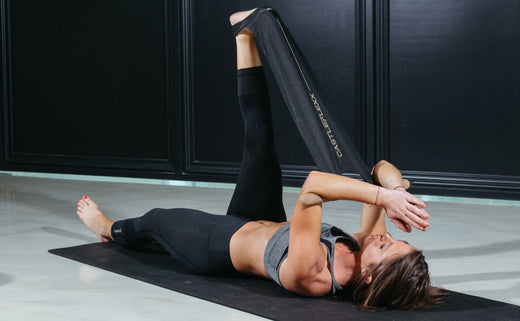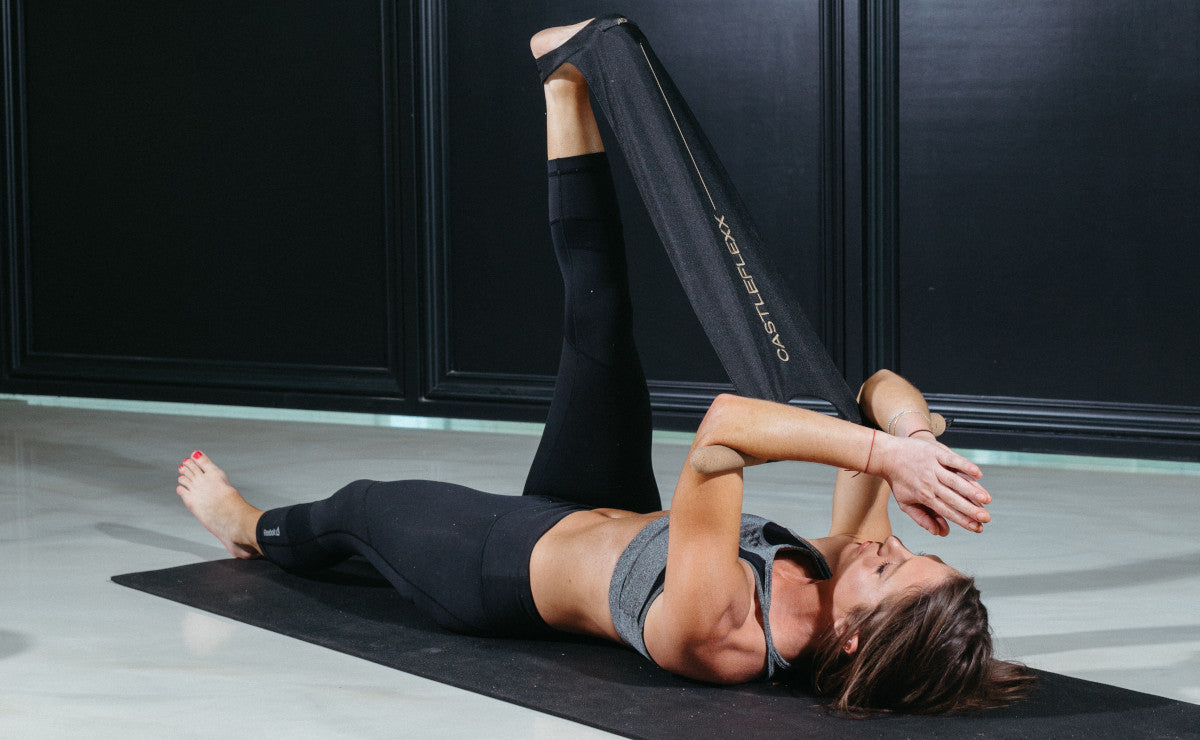Contents (Jump to a section)
How Does Stretching Prevent Injury?
 If you enjoy living a healthy, active life, you’ve likely experienced some type of injury that’s left you on the sidelines.
If you enjoy living a healthy, active life, you’ve likely experienced some type of injury that’s left you on the sidelines.
While some minor injuries are nothing more than frustrating inconveniences, others can be more serious. Bad injuries can potentially end your athletic career, and may require surgery or cause debilitating chronic pain.
Because the consequences of an injury can be so dire, athletes and fitness enthusiasts alike are constantly looking for ways to reduce their risks of damaging a muscle, bone, ligament, or tendon.
Stretching has become an integral part of pre-workout routines, often touted as a vital practice for injury prevention and improved flexibility. But what exactly is the science behind this, and does stretching prevent injury? If so, how?
Today, we’ll explore the effectiveness of stretching in preventing injury, and give you some tips for adding effective stretches to your daily routines to keep your body injury-free and enhance your physical performance.
Does Stretching Prevent Injury?
So, does stretching prevent injury? The short answer is yes. While there’s still a chance you can injure yourself even after you warm up and stretch properly, stretching dramatically and significantly reduces your risk of injuring yourself while exercising.
Stretching to prevent injury is a proven technique employed by professional athletes in just about any sport across the world, and should be an important part of your own physical wellness routine.
How Does Stretching Prevent Injury?
So, we know that stretching to prevent injury is a common practice, but how does stretching prevent injury? There are a few different reasons why stretching to prevent injury is so important - let’s take a look.
The Physiological Benefits of Stretching (Improved Blood Flow, Reduced Muscle Tension, etc.)
Dynamic stretching, involving controlled movements through a full range of motion, increases blood circulation to the muscles. This elevation in blood flow warms up the tissues and improves oxygen delivery, promoting better muscle function and reducing the risk of injury during subsequent physical activities.
Regular stretching sessions can alleviate muscle tension and tightness, allowing muscles to relax and be more pliable during movement. Relaxed muscles are less prone to sudden strains or tears, enhancing the overall flexibility and resilience of your muscles.
Stretching also encourages greater joint flexibility and range of motion, reducing the stress placed on surrounding structures during physical activities. This heightened mobility minimizes the risk of joint-related injuries and provides better functional movement patterns.
How Stretching Can Correct Muscle Imbalances
Muscle imbalances, a common issue resulting from overusing certain muscles while neglecting others, can lead to poor posture and an increased risk of injuries. Stretching can help correct these imbalances by:
- Targeting specific muscle groups, which addresses imbalances and leads to more symmetrical movement patterns
- Preventing overcompensation, which stops certain muscles from taking on additional strain, increasing the risk of micro-tears
The Role of Stretching in Post-Workout Recovery
Stretching after a workout is crucial for supporting the body's recovery process. Stretching after exercise can help alleviate muscle soreness and stiffness by flushing out lactic acid buildup and promoting better blood circulation.
This can enhance muscle recovery and reduce the risk of overuse injuries in subsequent workouts. Regular post-workout stretching also helps maintain and improve flexibility, preventing muscles from becoming excessively tight and vulnerable to injury over time.
The Difference Between Dynamic and Static Stretching From an Injury Prevention Standpoint
Dynamic stretching involves active movements that mimic the motions of the activity to be performed. It is particularly beneficial for warming up the body, increasing blood flow, and preparing muscles and joints for dynamic movements. As a pre-workout routine, dynamic stretching is considered more effective for injury prevention during activities requiring explosive or rapid movements.
Static stretching involves holding a stretch position for a period without active movement. While it remains beneficial for improving flexibility, static stretching before a workout may temporarily decrease muscle strength and power. Consequently, static stretching is more suitable for post-workout cool-downs or separate stretching sessions.
Tips on Getting Started Stretching to Prevent Injury
The effectiveness of stretching in preventing injury depends on several things, including your stretching technique, how frequently you stretch, and more. Here are some essential tips to help you get started with stretching to prevent injury.
Why Stretch for Injury Prevention With Castleflexx?
While certain dynamic and static stretches can help reduce your risk of injuries when performed solo, the benefits of assisted stretching shouldn’t be underestimated.
With special stretching equipment like the CastleFlexx, you can enjoy all the benefits of assisted stretching without the need for expensive and time-consuming visits to a physical therapist. So, why stretch for injury prevention with CastleFlexx?
The CastleFlexx is uniquely designed for both upper and lower-body stretching, making it the perfect all-in-one addition to your wellness routine.
With a patented design that targets the entire posterior chain of your lower limb, the CastleFlexx relieves tension across your entire body and helps prime your muscles for exercise, reducing your risk of injury. Previously only available to pro athletes, the CastleFlexx can now be yours!
The CastleFlexx isn’t only designed for injury prevention, it can also be a valuable tool to help you recover from workouts and rehab existing injuries.
If you want to learn how to increase ankle mobility, find some calf tightness relief, or discover how to stretch shin splints to reduce your shin splints healing time, the CastleFlexx is for you.
It’s also ideal for fixing tight hamstrings, doing stretches for glutes and hamstrings, and increasing hip mobility.
You can learn how long to heal plantar fasciitis with the CastleFlexx, and decrease your strained Achilles recovery time. You can even use the CastleFlexx to help fix tight glutes causing lower back pain.
The possibilities are endless with this device - and it belongs in your routine if you’re serious about injury prevention. Speaking of which, let’s talk about what creating a stretching routine entails.
Crafting a Stretching Routine to Suit Your Lifestyle
Designing a stretching routine that aligns with your lifestyle and fitness goals helps you stick with it, and reach your long-term fitness goals.
When creating a routine, first determine how much time you can realistically dedicate to stretching. Even short stretching sessions can be effective, so aim for consistency rather than lengthy, sporadic stretches.
Also, decide how often you can incorporate stretching into your schedule. Ideally, aim for at least three stretching sessions per week, but more frequent sessions can yield greater benefits. Explore different stretching techniques, and use both static and dynamic stretches. Variety can keep your routine engaging and target various muscle groups.
When to Stretch - Before, During, or After Exercise?
When it comes to stretching to prevent injury, timing is key. Dynamic stretching is ideal before a workout or physical activity. It helps warm up the muscles, increases blood flow, and prepares the body for movement. Save static stretches for post-workout cool-downs.
Some activities, like yoga and pilates, incorporate stretching into the exercise routine itself. These dynamic movements help maintain flexibility during the workout. After a workout, static stretching can be beneficial for enhancing flexibility, reducing muscle tension, and aiding in recovery. Include post-workout stretches in your cool-down routine.
Adapting Your Stretching Routine as Your Flexibility Improves
As your flexibility improves over time, it's essential to adapt your stretching routine accordingly. How long does it take to get flexible? It varies, but with CastleFlexx, your flexibility will slowly increase after each session. Gradually increase the intensity and duration of your stretches to challenge your muscles and continually improve your flexibility.
Also, explore more advanced stretching techniques or positions as you become more comfortable and flexible. Always focus on proper form and avoid pushing yourself too far beyond your current capabilities. Remember, no stretch should be painful!
The Importance of Consistency in Stretching for Injury Prevention
Consistency is key to reaping the benefits of stretching to prevent injury. If you need to, set reminders or calendar alerts on your phone to hold yourself accountable and stick to your routine. Also, choose stretches that you enjoy and that bring relaxation and satisfaction. Enjoyment increases the likelihood of sticking to your routine.
Precautions and Considerations When Stretching for Injury Prevention
Does stretching prevent injury, or is there a chance you can injure yourself while stretching? Although stretching is one of the best ways to prevent injuries, it’s also important to stretch correctly, as you could cause muscle strains by using incorrect stretching techniques.
When stretching to prevent injury, avoid bouncing during your stretches, as this can lead to muscle strains or injuries. Also, always warm up your body before stretching with some light cardio like jogging on the spot. This helps to increase blood flow to your muscles.
Other Ways to Prime Your Body for Injury Prevention Besides Stretching
Not only does stretching prevent injury, but there are a few other things you can do as well:
- Maintain a balanced diet to support muscle health and recovery
- Drink plenty of water to keep your muscles hydrated and flexible
- Include strength exercises in your routine to build muscle stability and protect joints
- Give your body time to rest and recover between intense workouts to reduce the risk of overuse injuries
Combined with the effectiveness of stretching in preventing injury, these tips can ensure you’re getting all the benefits of stretching without potentially putting yourself at risk of injuries.
Closing Thoughts on Stretching to Prevent Injury
How does stretching prevent injury? As you can see, stretching plays a critical role in preventing injuries by increasing blood flow, reducing muscle tension, correcting imbalances, aiding your safe recovery, and more. Stretching only takes a few minutes, but it’s a critical addition to your physical wellness routine.
Why stretch for injury prevention with CastleFlexx? Using the best stretching equipment like the CastleFlexx makes every stretch you do more targeted and effective. It’s an easy, affordable tool that could dramatically reduce your risk of sustaining an injury that could leave you on the sidelines, or worse, put an end to your athletic endeavors.
Don’t take that risk! Improve your strength, flexibility, and overall athletic performance by stretching with CastleFlexx.
